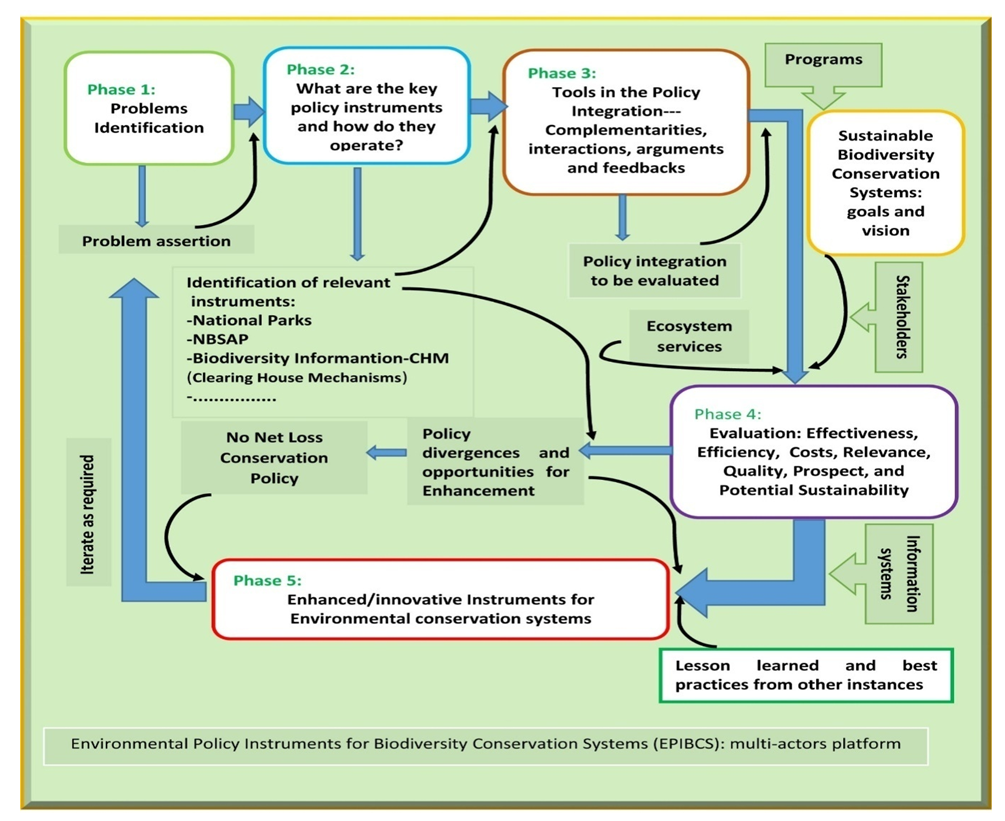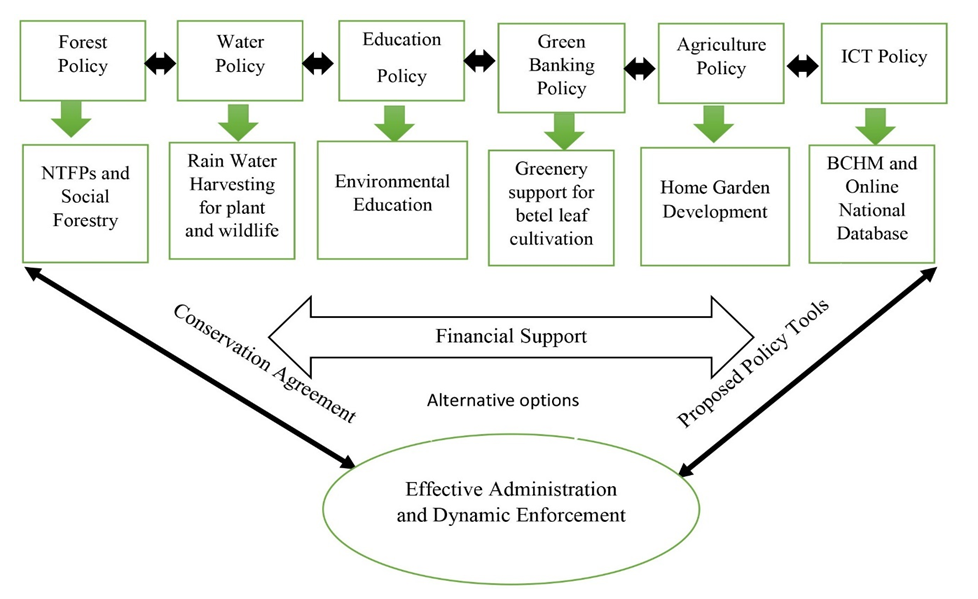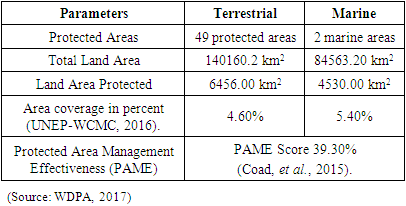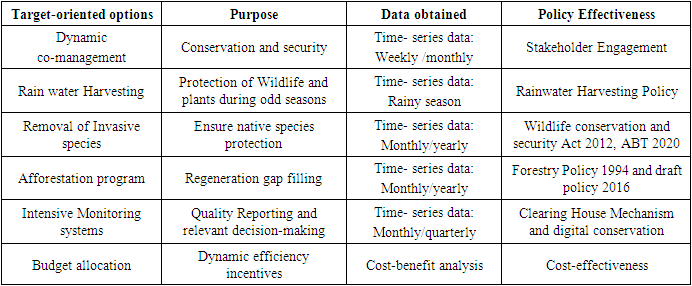-
Paper Information
- Paper Submission
-
Journal Information
- About This Journal
- Editorial Board
- Current Issue
- Archive
- Author Guidelines
- Contact Us
American Journal of Environmental Engineering
p-ISSN: 2166-4633 e-ISSN: 2166-465X
2023; 13(1): 1-12
doi:10.5923/j.ajee.20231301.01
Received: Dec. 5, 2022; Accepted: Dec. 29, 2022; Published: Jan. 13, 2023

A Framework on Biodiversity Conservation Related Policy Analysis
Md Rahimullah Miah1, Md Mehedi Hasan2, Jorin Tasnim Parisha3, Alexander Kiew Sayok
1Department of IT in Health, North East Medical College and Hospital, Affiliated with Sylhet Medical University, (SMU), Sylhet, Bangladesh. and PhD Awardee from the IBEC, UNIMAS, Sarawak, Malaysia
2Department of Law, Green University of Bangladesh, Dhaka, Bangladesh
3Government Satis Chandra Girls’ High School, Sunamganj Sadar, Sunamganj, Bangladesh
Correspondence to: Md Rahimullah Miah, Department of IT in Health, North East Medical College and Hospital, Affiliated with Sylhet Medical University, (SMU), Sylhet, Bangladesh. and PhD Awardee from the IBEC, UNIMAS, Sarawak, Malaysia.
| Email: |  |
Copyright © 2023 The Author(s). Published by Scientific & Academic Publishing.
This work is licensed under the Creative Commons Attribution International License (CC BY).
http://creativecommons.org/licenses/by/4.0/

Biodiversity is inextricably linked to humanity, which requires adequate policy instruments to properly conserve it. But some biodiversity criminals are misusing wireless sensor technology in a specific Global Positioning System location to cause global damage through destabilizing environment and climate crisis. All countries of the world are facing unexpected losses due to misuse of advanced wireless sensor devices. The study shows that dynamic policy, secure wireless sensor technology and co-management system inspire to conserve biodiversity. The study shows that a proportion of the achievement of the Framework for Action 2030 global biodiversity targets can be attributed to specific populations, tribes and protected areas. And another proportion may be controlled by particularly effective area-based conservation measures based on economic values, visitor motivation and scientific research priorities. By compensating for this unpredictable biodiversity, reforming current integrated policies to build a peaceful world will have a particular impact on meeting the Sustainable Development Goals. Research also shows that the active participation of UN states and the use of secure wireless sensor technology can actively contribute to the conservation of global biodiversity. Each country needs to have an existing and well-organized ecosystem with National Biodiversity Strategy and Action Plan (NBSAP), world-leading communication systems, science-based approaches to protection and management, and well-connected systems of ecologically representative and protected areas. Otherwise, everyone living on Earth will suffer severely and future generations will find it difficult to survive.
Keywords: Biodiversity, Policy Analysis, Framework, Effectiveness, NBSAP
Cite this paper: Md Rahimullah Miah, Md Mehedi Hasan, Jorin Tasnim Parisha, Alexander Kiew Sayok, A Framework on Biodiversity Conservation Related Policy Analysis, American Journal of Environmental Engineering, Vol. 13 No. 1, 2023, pp. 1-12. doi: 10.5923/j.ajee.20231301.01.
Article Outline
1. Introduction
- Bangladesh is one of the most vulnerable countries facing the effects of environmental degradation (Orts, 1995) due to misuse of wireless sensor technology including sensor tracking, collapse, blocking, virtualizing, poisoning and digital killing (Miah et al., 2022a,b). In addition to outdated policy instruments, lack of management strategies and fragmented political commitment also contribute to biodiversity loss (Miah et al., 2022a-e). Environmental policy instrument is connected with socio-economic factors with environmental considerations at the heart of decision-making on environmental issues among others includes biodiversity, climate change and ecosystem decline. Biodiversity is the core arena of these environmental issues. The current age of technological development is one of mass communication and luxury living, while a class of climate criminals are leading to alarming conditions of widespread environmental damage as a result of their alarming activities in unsafe wireless technology. On the other hand, administration and policy makers are still apathetic due to lack of advanced sensor technology knowledge. Environmental policy analysis framework is a set of actions to develop the task with relevant indicators to help the National Park management – as a case study teams in evaluating the performance of existing policy instruments, institutional and governance arrangements for ensuring the sustainability of National Park’s flora and faunal protection systems as well as the establishment of ecosystem services. Generally, environmental related tools for conserving of biodiversity did not exist innovative isolation from earlier legislative and institutional environment that surrounds them, but are part of a wider ‘National Park policy integration.
2. Materials and Methods
2.1. Site Selection
- The study was undertaken at Lawachara National Park (LNP) at Kamalganj sub-district in Moulvibazar of Sylhet division, Bangladesh coordinates with 24°32′12″N 91°47′03″E (NSP, 2005) as the forest conservation case study site. The study also followed the methods for data collection from the following URLs: URL: https://ir.unimas.my/id/eprint/24535/ URL: https://ccsenet.org/journal/index.php/jpl/article/view/0/47787 URL: http://article.sapub.org/10.5923.j.bioinformatics.20211101.01.htmlURL: http://article.sapub.org/10.5923.j.ajbe.20201001.03.html URL: http://article.sapub.org/10.5923.j.fs.20211101.01.html URL: https://ojs.bilpublishing.com/index.php/jer/article/view/2826/2632 URL: http://article.sapub.org/10.5923.j.diabetes.20200902.02.html URL: http://article.sapub.org/10.5923.j.ijvmb.20211001.03.html URL: http://article.sapub.org/10.5923.j.scit.20211101.02.htmlURL: http://article.sapub.org/10.5923.j.geo.20211101.02.htmlURL: http://article.sapub.org/10.5923.j.ijas.20211102.02.htmlURL: http://article.sapub.org/10.5923.j.env.20211102.01.htmlURL: https://ccsenet.org/journal/index.php/gjhs/article/view/0/46717 URL: http://article.sapub.org/10.5923.j.ijim.20221101.01.html
2.2. Data Collection and Organizing
- At first, all the general information regarding the policy assessment, building a framework and implantation as a biodiversity conservation instruments towards Lawachara National Park. and informatics including biodiversity conservation systems in the Lawachara National Park and their diversity, status, and distribution are collected and tabulated in an organized manner. Besides, Global Development Plan (GDP), National Biodiversity Strategy and Action Plan (NBSAP), Clearing House Mechanism (CHM) and protected areas status of State Parties in South East Asian, After the data had been collected, they were checked properly for accuracy, by using the crosschecking method for data compilation.
2.3. Data Analysis, Presentation and Interpretation
- All general information regarding the occurrence of biodiversity and national parks including legal systems in the protected area and their diversity, status and distribution were checked for accuracy from the different sources and sources of information were also verified. Information regarding the initiatives of the authority towards the conservation of biodiversity was collected through relevant secondary information and field survey. Then the information was included in the preparation of data master sheet and incorporated into convenient forms used in the result and discussion section. The data were compiled and analysed for presentation and interpretation using suitable data analysis software like MS Office Suite 2021, SPSS ver.27 and R programming version 5.4 for suitable interpretation.
3. Results and Discussion
3.1. Effectiveness of Protected Areas in South East Asian
- The implementation and effectiveness of National Parks are influenced by diverse social, economic, political and technological factors (Maciel et al., 2008). National Parks (NPs) are instrumental in supporting biodiversity conservation as well as providing many benefits. Asia is the most populous region in the world, with a substantial number of global biodiversity hotspots (Myers et al., 2000) and several megadiverse countries, like Malaysia, with rich cultural and natural heritages (NPS, 2016). In this region, the natural heritage with protected areas is under threat with high tendency to losses of biodiversity is continued (Mulongoy and Chape, 2004). This study tries to relook at the key factors that strengthen the policy towards conserving biodiversity at National Parks (NPs) of Bangladesh and Sarawak, Malaysia. There is comparative analysis on the quantity of protected areas in Asia to compare with 1990 and 2014, as shown in Figure 1. The study suggests for learning and taking decision from each other country on increase on protected areas (Juffe, et al., 2014) individually. Different parameters on protected areas of Bangladesh are mentioned with terrestrial and marine in Table 1. However, National Park is a type of environmental conservation tool in national and global supporting biodiversity conservation (Balmford et al., 1995) and providing various benefits. These parks include the peak portion ( about 23%) of the entire global region protected (Chape et al., 2003; Muhumuza and Kevin, 2013). In terms of coverage, the terrestrial national park areas have augmented to continue (UNEP-WCMC, 2017; UNEP-WCMC, 2016), which documented in Figure 1. These Parks (NPs) are also good instruments for biodiversity conservation in Bangladesh.
|
 | Figure 1. Protected areas of State Parties in Southeast Asia between 1990 and 2014 (Source: Juffe, et al., 2014) |
 | Figure 2. Gross Domestic Product of Asian Countries (Source: GEP, 2016) |
3.2. Outcomes of Results for Updating NBSAP of Bangladesh
- Update NBSAP is the basic instrument for implementing at national level for the purpose of state biodiversity conservation. It has been updated in order to fulfil the commitment of Bangladesh towards implementing the specific objectives indicating (a) national biodiversity conservation, (b) effective and justifiable use, and (c) reasonable and unbiased allocation. National Focal Point (NFP) of Bangladesh is the coordinator to implement of the NBSAP with cooperation of other Ministries, agencies, organizations, institutions, academic institutions, and co-management team for actions that fall within their responsibilities. The revised NBSAP (2016) creates new idea than that of NBSAP 2004, as shown in Figure 3. The update NBSAP highlights as follow:(a) Aichi Biodiversity Targets (ABTs), (b) Biodiversity Clearing House Mechanism (BCHM), (c) Adoption of local and traditional knowledge, (d) Sustainable Development Goals, (e) Update National Policies, (f) Digital conservation technologies, and (g) Stakeholders engagement.
 | Figure 3. Input updating NBSAP of Bangladesh |
3.3. Develop National Biodiversity Clearing House Mechanism Model
- A planned stronger and operative clearing house mechanism developed new multi-channels of communication globally, such as (a) support development of environmental awareness, (b) creating associations to the on-going nature conservation activities, (c) Consciousness levitation, (d) biodiversity information broadcasting. The study illustrates the participation of all the sponsors for necessary actions of national government and non-governmental organisations, private industries, local community leaders, Network Specialists, ICT Company, Park Manager, Team Leader of Co-Management Committee, Indigenous community Leader, Academician, Biodiversity Specialist, Botanists, Zoologists, Researchers, Environmentalists and Lawyers, Local Government Leaders, Policy-makers and effective other stakeholders. The biodiversity clearing house mechanism creates new effort to the national conservation awareness and disseminating worldwide through online connection as well as interlinked with CBD and other state parties (Figure 4). This model will be enhanced by the state party for developing of national biodiversity clearing house mechanism, which fulfils the requirements of CBD’s CHM. For example: National Plant Species Database, Wildlife Database, National Park Database and so on. These are interlinked with clearing house mechanism either state party as well as Convention on Biological Diversity. This model also can enhance national reporting to CBD. The assessment of the study that it is connected with world database on protected area, Asian protected area network, CBD state parties’ networks, IUCN Red List Database, Global Taxonomic Database, Conservation International Database, Taxonomic Database Working Group and digital conservation related new network database. The BCHM is suitable for information dissemination and collection by the researchers, academia, scientist, botanists, zoologists, biodiversity specialist, taxonomists, environmentalists, Lawyers, Environmental educationists, Digital conservationists and natural science philanthropists with development of biodiversity.
 | Figure 4. Development Model for Biodiversity Clearing House Mechanism |
3.4. A Dynamic Framework on Environmental Conservation Policy Analysis
- Environmental Policy Instruments for Biodiversity Conservation Systems (EPI-BCS) is a case study site at Lawachara National Park: A biodiversity policy integration is a combination of environmental policy, biodiversity policy and agriculture policy instruments, which has an influence on the resources efficiency and sustainability of biodiversity conservation including clearing house mechanisms, with a particular focus on co-management inputs and rain water harvesting. An innovative approach assesses policy instruments in different fields, like– wildlife protection and security, revised NBSAP, Policy mix Nishorgo Support Project, Clearing House Mechanism. Overall, this assessment indicated to the problems identification of existing instrument, then includes effective policy operations for integration with feedbacks and performance, then evaluation for effectiveness and potential sustainability, and lastly the innovative instrument disseminates for sustainable conservation towards National Parks according to the provision of ecosystem services. The study illustrated the main steps of the EPI-BCS policy analysis framework includes 5 procedural steps operating in a sequential and iterative mode. These Phases are, (i) Phase 1: Problems Identification, (ii) Phase 2: Select instrument and its operation, (iii) Phase 3: Policy Integration, (iv) Phase 4: Policy Evaluation, and (v) Phase 5: Enhanced Innovative Instruments for sustainable environmental conservation, as shown in Figure 5.
 | Figure 5. Phases and outcomes of the EPI-BCS policy analysis framework |
|
|
|
 | Figure 6. Policy Instruments and policy mixes |
3.5. Effectiveness of Environmental Conservation Policy and Determination
- The Government of Bangladesh controls Lawachara National Park. Therefore, the government expected to take comprehensive goals for promoting involvements among the Forest Department, Department of Environment, Water and Agricultural Sector. One of the advances of them intersects the improvements of unique objectives. In this condition, policy makers should to substitute advances in one instrument through damages among each other, which delivers rules and regulations to pertinent performers and stakeholders to accomplish better quality, shown as in Table 5.
|
 | Figure 7. Performance evaluation of selected policy instruments |
3.6. Prospects for Presenting Innovative Tools
- The study proposed to identify propositions for innovative conservation policy instruments (Figure 8) towards Lawachara National Park with the update on enforcement of Wildlife Conservation and Security Act 2012 as per the requirements of CBD policy. The existing Act of Bangladesh connected with other relevant policies, like Education Policy for Environmental Education, Green Banking policy for betel leaf cultivators, Agriculture Policy for Home Garden, Forest Policy for Social Forestry and ICT policy for Biodiversity Clearing House Mechanism. The presenting of innovative instruments recognised gaps, with the aims to support supplementary and synergies as well as to evade conflicts and restrictions. The study tries to analyse different data according to its objectives with graphical and tabular formats. The research reveals the environmental policy instruments using information systems for conservation of biodiversity towards National Park. For this purpose, the study finds several mathematical views as well as logical views regarding applications of biodiversity information systems and its stakeholders’ opinions, growth of National Parks and its distribution, clearing house mechanism and its present status, NBSAP and its structure to compare with other state parties, controlling measure of Invasive Alien Species, and relevant policy status and comparing with Malaysia’s policy (Miah et al., 2017).
 | Figure 8. Environmental Conservation related new and alternative policy instruments |
3.7. Progress of Implementation and Efficiency
- Lawachara National Park Biodiversity Research is connected with progress of implementation and efficiencies depending on the Government of Bangladesh. The research is based on bioenvironmental policy and technology for conservation of biodiversity towards national park. As a State Party, Bangladesh ratified with CBD to ensure commitments for sustainable use of natural resources. For these purposes, Government of Bangladesh takes initiative regarding the agreement for proper implementation and efficiency until to date. Government developed biodiversity related law and policies, plans, and strategies and to continue for formulation, update, modification and reforms according to institutional requirements. Some targets also delay in time for start-up is being compensated for with an extension period 2016 to 2021. Implementation delays were also caused by cumbersome procedures within participating state party government for update NBSAP, new declaration of national parks, new law on the wildlife conservation and security Act 2012, announcement bid for national biodiversity clearing house mechanism. In Bangladesh, further implementation delays were faced mainly because of national procedures for hiring consultants for services and studies. With the good coordination of IUCN, UNDP, GEF, USAID, IPAC and other agencies, the updated NBSAP has been implemented efficiently and has achieved a number of outputs and outcomes. Obtainable inputs and means have been assigned in a transparent and sufficiently flexible manner to where they are most obligatory resulting in tangible outputs with the co-operation of co-management team. Implementation has been adjusted to the reality on the grounds and to the scope for action in different national parks of Bangladesh, particularly Lawachara National Park in Sylhet division. A high number of good-quality outputs have been formed and disseminated to the pertinent target groups and beneficiaries. The several partners are involved in work planning and provide proper progress reports. The National Contact Point also submitted the fifth national report to CBD in time. The grant financing of Lawachara National Park is maximum from the period of 2009 to 2014 than other national parks in Sylhet, which stands out in its achievement as an impressive volume of task with significant impact. Bangladesh currently achieved 106.613 square kilometres of marine area including 19.469 sq. km in the Bay of Bengal in 2014 by a legal judgement of United Nations Tribunal (Turley et al., 2016). On the other hand, the administration of Lawachara National Park achieved 20 acres’ area from illegal encroacher in January 2017 (ALNP, 2017).
3.8. Conservation Instruments – Effectiveness to Date
- CBD is well on track to achieving most, if not all, premeditated Aichi Biodiversity Targets on time if the necessary course corrections (Bruner et al., 2001) are time-honoured. It has supported the promotion and implementation of NBSAP and BCHM of each state party of CBD within stipulated time. The Government of People’s Republic of Bangladesh (MoEF) has approved the Bangladesh Biodiversity Act, 2017, while the Ministry of Environment and Forests announced circulation for bid on BCHM. The research is making a big step effectively introducing environmental policy instruments along with information systems for conserving biodiversity towards national park in Bangladesh, to be incorporated into divisional and district –level plans and actions according to national policies and CBD guidelines/ requirements. Media coverage efforts are being strengthened to raise the national parks, and numerous articles have been published in refereed international journals and conferences.The discussion on analysis of research findings on environmental policy instruments, along with the assessment of information systems evaluates the biodiversity conservation at Lawachara National Park in Bangladesh.
4. Conclusions
- In conclusion, the findings on the existing policy instruments are inadequate in connection with national and global perspectives, where there are some gaps, like policy formulation, sectoral integration, national park declaration, establishment of digital conservation and insecure wireless sensor networks surrounding national park areas. The researches try to find the policy analysis, its effectiveness to the Aichi Biodiversity Targets 2020. As a developing country, Bangladesh has little research on environmental policy instruments for conserving biodiversity, where there are many analysis gaps. In this regard, the research finds suitable argument on the priority of observing gaps solving with a scientific framework.
5. Declaration
- FundingThis research work is a part of PhD Thesis, which was funded by the Zamalah Postgraduate Scholarship of UNIMAS, Malaysia and also sponsored by the Information and Communication Technology Division, Ministry of Posts, Telecommunication and Information Technology, Government of People’s Republic of Bangladesh. The funders had no role in the design of the research, in data collection, analyses or final interpretation of data, in the writings of the manuscript, or in the decision to publish the findings.Data AvailabilityData being used to support the findings of this research work are available from the corresponding author upon request. Competing InterestsThe authors declare no potential conflict of interests in this research work.
ACKNOWLEDGEMENTS
- The authors acknowledged the authority of Universiti of Malaysia Sarawak (UNIMAS), Malaysia for providing the Zamalah Postgraduate Scholarship for the completion of PhD degree. The authors are also grateful to the authority of the Information and Communication Technology Division, Ministry of Posts, Telecommunication and Information Technology, Government of People’s Republic of Bangladesh, for PhD Fellowship during the higher study in Malaysia. The authors acknowledged the authority of North East Medical College affiliated with Sylhet Medical University, Sylhet, Bangladesh for kind supports.
 Abstract
Abstract Reference
Reference Full-Text PDF
Full-Text PDF Full-text HTML
Full-text HTML



